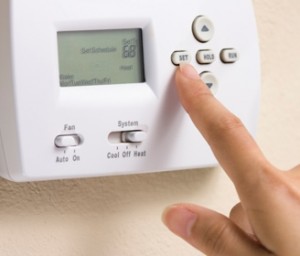Biggest Energy Myths Busted
MYTH #1: Closing Off Vents Saves Energy
Though it seems that closing vents in unused rooms would save energy, the energy consumed by the system is at the unit itself, and restricting conditioned air at a vent termination redirects it to other locations in the house or through leaks in your duct system. Closing vents also puts backpressure on the fan that pushes the air through the system, causing it to work harder, use more energy, and wear out faster.
MYTH #2: Temperature Kept Constant Saves Energy Over Raising And Lowering It
 Why would you want to heat your house while you’re at work, or while you’re cozy cuddled up in your down comforter? Keeping your thermostat at a constant temperature is a waste. If you’re at home during the day, set it to 68 degrees. At night, turn down the thermostat to 55 degrees. Every degree you lower to on your thermostat between the 60 and 70 degree range, lowers your heating costs by 5%.
Why would you want to heat your house while you’re at work, or while you’re cozy cuddled up in your down comforter? Keeping your thermostat at a constant temperature is a waste. If you’re at home during the day, set it to 68 degrees. At night, turn down the thermostat to 55 degrees. Every degree you lower to on your thermostat between the 60 and 70 degree range, lowers your heating costs by 5%.
MYTH #3: Turning Thermostat On High Heats Rooms Faster
This one is common sense. If you crank your thermostat up to 90 degrees, hoping it’ll heat your home faster than setting it at the constant temperature you’d like to reach, you’ll be disappointed. Your heat pump can only work so hard and so fast. A furnace will provide heat at its max power (or a fraction of max power for multi-stage units) when it is first turned on. So, setting the temperature higher will have little effect in how quickly a home heats. Setting the thermostat higher does have the potential to increase the run-time of the heating system, using more energy and potentially making your home uncomfortably hot.
MYTH #4: Ceiling Fans Don’t Work During Winter
We all know heat rises. But what if you could pull it back down to where you’re curled up on the couch wrapped up in your Snuggie? Most ceiling fans have the ability to do that. Reverse the switch on your fan so the blades blow upward. It forces the heat back down to thaw you out on a cold winter day.
MYTH #5: Fireplaces Are Efficient
Do you have a traditional fireplace? Many are big energy losers. They suck the heated air from the house and pull it up the chimney. So, if you’re not using it, close the damper. Wait until the smoldering embers are out first.
MYTH #6: Can’t Insulate An Old Home – It’s Not Cost Efficient
If you don’t have proper insulation, cold air can seep in through walls, floors and especially ceilings. Warm air can escape. Don’t forget to seal leaks, install weather-stripping on leaky doors. Lack of weather stripping could amount to a 15% higher heating bill.
MYTH #7: New Homes Must Be Efficient
Just because a home is new, doesn’t necessarily mean that it was built efficiently. A home’s efficiency is less correlated to its age than to its design and construction. While many new homes are considered to be more efficient, there is often room for improvement and savings.
MYTH #8: Close Blinds To Keep The Heat Inside
Not on a sunny day. Let the rays shine in and heat your home free. Yes, having the blinds closed at night does help insulate your home.
MYTH #9: New Windows = Significant Cost Savings
Replacing single pane windows for energy star rated dual pane windows will save energy. That energy savings, however, is a function of the size and number of windows in your home, their orientation and overhangs, and the location of your house and the climate zone you are live in. This typically amounts to a small fraction of your total energy use, and given the expense of replacing windows, there are typically much more cost effective ways to reduce your energy bills.
MYTH #10: Using An Electric Space Heater Saves Money
Given that electricity is typically between four and 10 times the cost of natural gas, running just two electric space heaters can cost the equivalent of heating an entire home with a gas-powered system.
MYTH #11: Leaving a Light on Uses Less Energy Than Turning It Off, Then on Again
Some people actually believe that if leaving the light on when they leave the room for a few minutes to take a restroom break, for example, is better than turning it off and then on again when they return. There is no significant additional power draw when turning on a light bulb (other than the calories you use by flipping the switch). So, turn off the lights each time you leave a room, even if for just a couple of minutes.
Courtesy of Forbes.com
